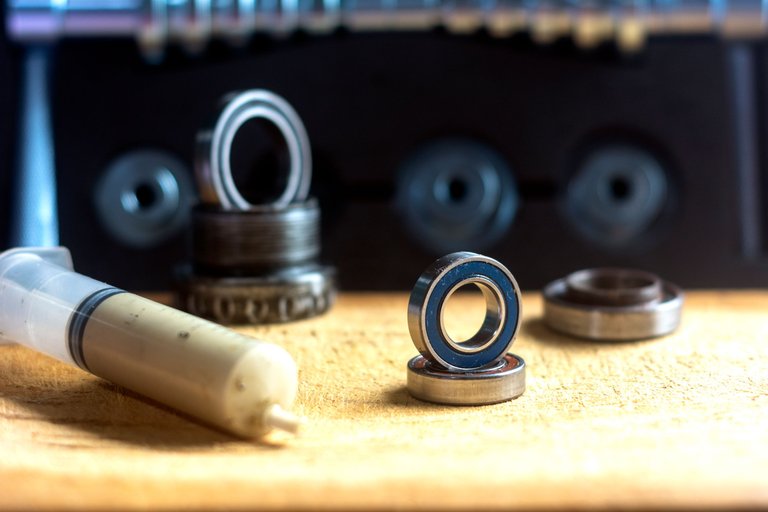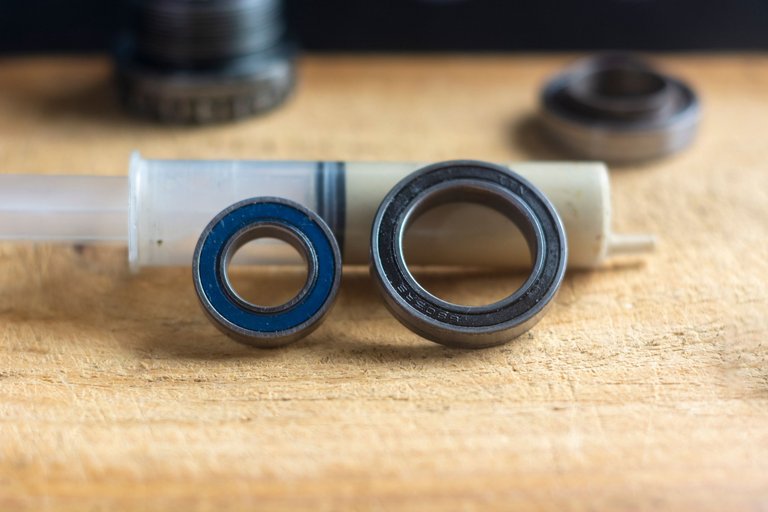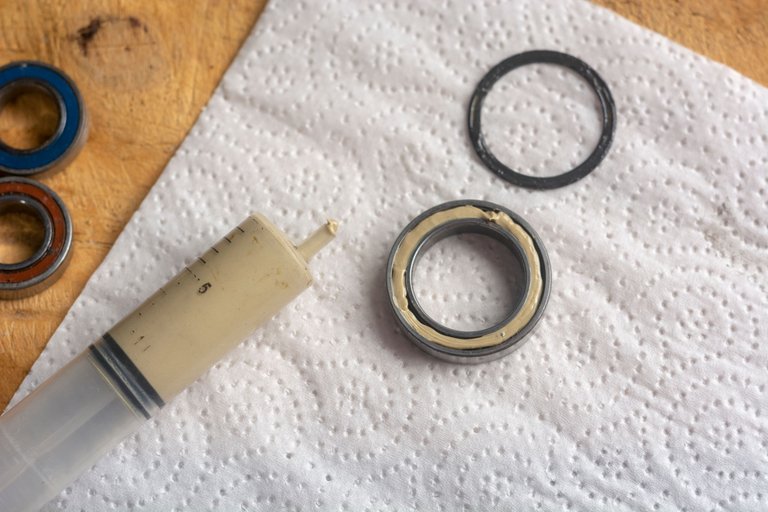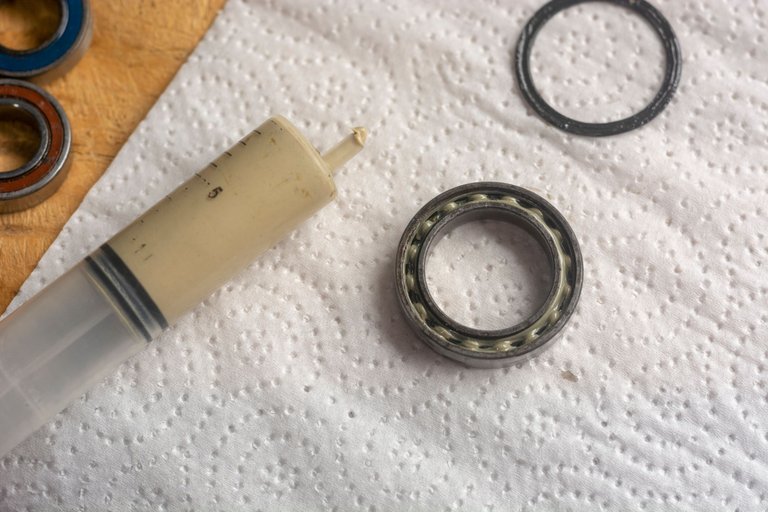Cycling: Bearings, Lubricant & Speed discussion
Heeeyho Readers! Have you ever tried to make your bicycle faster?
A friend and I got into an interesting conversation about bicycle bearings.
"Will better wheel hubs make my bicycle faster," he asked. I told him it depends. Depends on what he's comparing: isolated hub bearings, a whole wheel set, bearings vs. cup-and-cone, etc.?
Common knowledge states that hubs with quality bearings indeed save energy and make the wheels spin easier compared to cheap entry level parts (e.g. cheap chinese bearings or poorly adjusted cup-and-cone hubs). It's a combination of better-machined components yielding stricter tolerances and smoother rolling surfaces. In that sense, yes, upgrading from an entry level set of wheels to intermediates will be quite noticeable. However, is there real gains for someone already using intermediate parts? How about paying extra for industry-grade bearings, is it worth it?
The whole debate revolved around finding ways to make the bikes faster, which prompted the idea for today's post. Let's discuss bearings, plus some personal tips for the fella cyclists regarding the subject.

After much talking, we got to the following assumptions:
1. Amateurs power output vary so much that 10 Watts gain in rolling parts makes no difference.
2. Amateurs gain more from training than from expensive parts.
3. There's no huge difference between bearing quality offered in most intermediate hubs/bottom-brackets.
4. Grease quality and correct amount is more important than paying extra for premium bearings.
5. Biggest gain in more expensive parts is in durability and not on speed.
Why paying extra then?
"For durability", I reinforced. We want our bearings (hubs and bottom-brackets) to last as long as possible to avoid unnecessary maintenance costs. That, of course, is pricey.
Cheap bearings are often machined using low quality steel while also having less quality control, hence, are a lot less durable. Industry-grade bearings (SKF, NTN, FAG, etc) will last more than third grade counter-parts, whilst also having less friction due to stricter construction tolerances.

How about the speed?
In my view, the correct use of grease is more important than the installation of super duper high quality industry-grade bearings. I often see mechanics packing bearings full of grease 'till it spills through the seals. The result? Excessive grease will make the balls inside the bearing slide instead of rolling, thus creating more friction; not enough grease will generate heat and greatly wear out the bearing. Read further to learn more.
The same applies for the grease thickness. Thicker greases generate more rolling resistance than oil, for example. Choosing the correct grease can potentially make the wheels spin faster.
All about greases
Alright. I believe we established two points here:
- more expensive bearings have greater impact on durability than on speed
- the correct use of lubricant can influence speed
How can we take advantage of available lubricants? The best way is to, first, chose the correct one. Grease comes in different consistency grades, as follow.

Our bicycles are well-served with grades NLGI 1 or 2, which are common greases, including premium bicycle-specific versions offered in bicycle stores. Anything higher than 2 will increase friction greatly.
Sure, you may have heard of pro athletes using oil in their bearings. Myth or not, they also have a plethora of wheels to swap and mechanics servicing their bicycle after each race — not our case.
There are many other qualities to account for (such as viscosity, water resistance, corrosion resistance, etc), but let's spare the headache. Basically, for hub and bottom-bracket bearings, any lithium or calcium-based grease will work perfectly fine. I personally use calcium-based maritime (NLGI 2) grease because it's cheap and readily available at the local hardware store. My mechanic uses the famous Shimano grease, which is also grade 2.

The real secret is packing the correct amount of grease into the bearings. As mentioned before, grease in excess creates a lot of drag and prevents the balls from properly rolling (slide effect). Here's how the industry determines:
- 1/2 to 2/3 of the free space in the bearing when operating speed is less than 50% of the limiting speed
- 1/3 to 1/2 of the free space when the speed is more than 50% of the limiting speed of the bearing
Bicycle bearings operate in super low RPMs compared to spec, meaning we can safely fill 1/2 of the bearing with grease; one side filled lets the grease spread to the other side. See below.


This is enough lubricant to safe-guard the bearing's functionality without creating a lot of drag. I'm yet to test different grease types and densities to test for durability. Rolling resistance, at this level, is neglectable and only measurable in lab. Why bother?
Ceramic bearings
Oh, that fuzzy topic. Do we really want to delve into that? Let me know in the comments if you'd like to know more about ceramic bearings. I think it's an interesting topic, but only if more Hivers are interested.
Conclusion
All the information I know about bearing lubrication is condensed in here. Even though resumed and simplified, I believe there's a lot to take from the info if you're into servicing bicycles at home. In essence, the correct lubricant and its use has more impact than buying expensive bearings/hubs/bottom-brackets. Change my mind?
I'd love to hear your instance on the subject and learn from your experience.
Peace.
If you enjoyed this post consider leaving your upvote for a hot coffee.
Find me on Twitter: https://twitter.com/mrprofessor_
~Love ya all,
Disclaimer: The author of this post is a convict broke backpacker, who has travelled more than 10.000 km hitchhiking and more than 5.000 km cycling. Following him may cause severe problems of wanderlust and inquietud. You've been warned.

Good to know. All the bikes in my house are getting old and I am sure the bearings could do with some grease.
!LUV
!LOL
!ALIVE
!PIZZA
@mrprofessor! You Are Alive so I just staked 0.1 $ALIVE to your account on behalf of @ new.things. (7/10)
The tip has been paid for by the We Are Alive Tribe through the earnings on @alive.chat, feel free to swing by our daily chat any time you want, plus you can win Hive Power (2x 50 HP) and Alive Power (2x 500 AP) delegations (4 weeks), and Ecency Points (4x 50 EP), in our chat every day.

Go for it! And be prepared for wild wife shouts if you clean dirty bearings in the laundry sink (personal experience)
$PIZZA slices delivered:
@dejan.vuckovic(2/5) tipped @mrprofessor
new.things tipped mrprofessor
Bearings... Nice subject!
As an amateur I Agree
Same for this one! I see so many cyclist buying such expensive full carbon bicycles for the 2 kilogramms less weight they have. But they carry around 50 kilo's of excessive weight themselves. Oh well, If they have the money for it, why not.
At least they are excercising, so who am I to judge...
But does the extra price weigh up against the longer durability. That is more the question I think.
I think durability has more to do with maintenance. I would state that if you cannot or don't want to maintain certain parts, you'd better buy cheaper ones.
Thanks for sharing this interesting topic!
This post was upvoted by the Cycling Community
Subscribe to the Cycling Community and share your cycling related posts with us.
Join our Discord Channel if you want to chat about cycling.
You can support the Cycling Community by delegating HP
| 25 HP | 50 HP | 100 HP | 250 HP | 500 HP |
That's a good question.
Specifically talking about wheel hubs (and their bearings) here. What I see is that more expensive hubs are better sealed and have quality bearings installed -- the result is less maintenance and more durability compared to cheap ones.
We could analyze two things:
I'd love to compare my rear hub (ARC Mt009 - 60 USD) versus a Dt Swiss 350 (200+ USD) -- unfortunately I don't have data for that. Inspected mine after 10k and the bearings are still brand new. Before swapping to the ARC I blew a cheap "white label" hub that came originally on my bicycle with less than 10k -- damage was so bad it was cheaper to swap the entire hub.
When my bearings blow up I'll swap them with quality industrial SKF so we can compare, but it'll take quite some time hahaha
As a mountain bike rider, I spend a lot of time maintaining hubs and bearings. The problem I am facing is related to the much higher amount of dust, sand and mud trying to damage parts of the bike, as well as the fairly humid conditions in which MTB bikes are used.
At first, I used high-end maintenance components. By that I mean the best bearings I could get, usually SKF because their offer on the local market is very good. However, over the years I have started to use slightly cheaper solutions for some parts that show less fatigue.
Just to put things in perspective, most road bikes have 8 bearings, 10 if you include the ones in the headset. The average full suspension MTB can have up to three times as many bearings depending on the rear suspension design. That's a lot more money when using premium components for maintenance. Also, I have found that some of the suspension bearings, especially those exposed to lower lateral forces, show less wear, even under extreme conditions. My last bearing change was - top quality SKF bearings in the front and rear hubs, and as well in the main suspension pivot. In all other positions, I installed much cheaper bearings from unknown manufacturers (ie Chinese middle class).
Lubricating the bearings I did only in terms of preventing moisture and dirt from getting to them. One of the experiments with removing the protective rings around the bearings and reinstalling them showed me that no matter how carefully I do this action at home, the protective rings never show the same resistance to external factors as factory new bearings.
In addition, some bearings on MTB bikes are literally impossible to remove from the frame without damaging the bearing, and even those where it is possible require a special tools, a lot of time and careful work in order not to damage the frame. I went with logic - when I'm already going through so much work, I better install new bearings :)
For lubrication, I usually use grease recommended by the manufacturer. I know that a DT Swiss 20g tube of Grease costs twice as much as no name grease of the same viscosity (same at least on paper), but the bikes I maintain are worth much more than the 11.99 a tube of grease costs :)
!BEER !PIZZA
Great comment! So, in your experience, is it worth it installing SKF bearings on hubs? I use that Chinese ARC mt009 rear hub from AliExpress and it's still going strong after 10k kilometers and many many bangs on rock gardens... I wanna see how long until the bearings give away so I can compare to SKF (it'll take a looooong time so we have that data). My previous generic rear hub didn't make it that far in the same environment (blew both freehub bearings which also destroyed the freehub casing).
In terms of grease I use maritime calcium-based nlgi-2. I wanna switch to premium grease but don't have cash atm.. they smell nicer and seem to take a lot longer to become all black.
In my experience, there is a difference between premium SKF bearings and Chinese copies, primarily in durability and resistance to external factors. The rolling resistance is so low that I didn't notice the difference. My driving style is far from consistent and I am far from being able to notice such small fluctuations :)
I found information on several forums that premium bearings at the beginning of use, the first hundred kilometers or so, have a little more resistance - probably until the lubricant is brought to working conditions.
What I noticed during maintenance is that the durability of premium bearings to lateral forces and the sealing of the cartridge is much better. I noticed this first of all on the bearings of the main pivot of the suspension, which are the most exposed to such forces and dirt. It is very difficult to notice differences in durability on hubs since any bearings literally last for tens of thousands of kilometers without problems, as you yourself noted. What I was guided by when choosing premium bearings is the fact that the process of replacing bearings in a free hub requires a lot of work, so even the potential delay of service for several months or year is reason enough for the investment.
Gotcha! I might try SKF on my GXP cranks. GXP are notoriouly faulty in terms of design, but perhaps better bearings will help... Enduro (brand) bearings didn't last, not to mention cheap ones.
Yup, it's quite annoying. I do have the tools, however. Bearing pullers, press and all that stuff you can find fantastic quality ones on Aliexpress
I have no experience with the Sram GXP set as all my bikes use some Shimano hollowtech. Wheel sets are DT Swiss & Shimano XT, so no Sram there neither :) Anyway, I hope good bearings will help. Let me know how it went when you have some conclusions
Haaaaa to broke backpacker... Uyyy strong... Haha one day I would like to travel by bike, that would be great... And about the fat... It's important and I will keep it in mind as soon as my chances of having a better health increase. equipment and spare parts, while I do everything possible to make my bikes work, I am also broke, you do what you can, however, I was interested in learning and getting to know myself so that at some point I can put it into practice